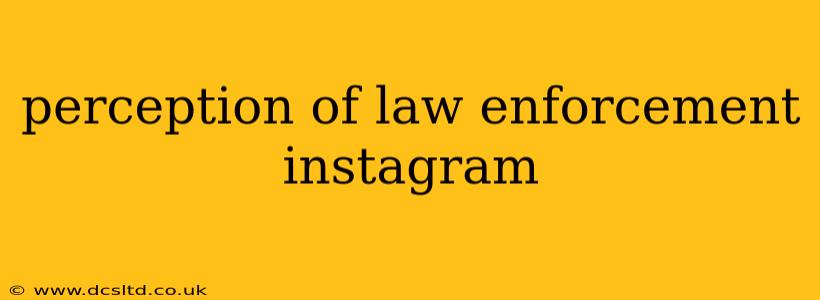Instagram, a platform brimming with visual narratives, offers a unique lens through which to examine public perception of law enforcement. This perception, however, is far from monolithic. It's a complex tapestry woven from diverse experiences, individual biases, and the carefully curated content shared by both law enforcement agencies and individual officers, as well as citizens. This post delves into the multifaceted nature of this online portrayal, exploring both positive and negative aspects.
What are some common portrayals of law enforcement on Instagram?
Instagram presents a spectrum of law enforcement portrayals. On one end, we see highly polished accounts showcasing community engagement initiatives: officers interacting with children, participating in local events, and highlighting successful crime-solving efforts. These posts often aim to humanize officers, fostering a sense of connection and trust with the community they serve. The use of bright, positive imagery and feel-good captions reinforces this message.
On the other end, we encounter posts depicting tense situations, arrests, and the realities of dangerous encounters. These images, while often necessary for transparency, can fuel negative perceptions if not carefully contextualized. The potential for misinterpretation and selective highlighting of specific incidents is high. The lack of comprehensive narratives alongside such visuals can reinforce pre-existing biases.
How does Instagram contribute to the public's understanding of law enforcement?
Instagram's visual nature plays a significant role in shaping public perception. A single image or short video can powerfully convey an emotion or narrative, bypassing lengthy explanations. This immediacy is both a strength and a weakness. While it can foster empathy and understanding, it can also lead to oversimplified or biased interpretations. The algorithm, which prioritizes engaging content, often favors sensationalized or emotionally charged posts, regardless of their accuracy or completeness. This can inadvertently contribute to a skewed understanding of law enforcement realities.
What are the challenges of using Instagram for police departments?
Using Instagram presents distinct challenges for law enforcement agencies. Maintaining a consistent brand image while navigating diverse public opinions is a constant balancing act. The risk of negative comments, misinformation, and the potential for viral misinterpretations is ever-present. Moreover, the need for transparency can clash with the sensitivities surrounding investigations and operational security. Balancing public information with protecting ongoing investigations is a delicate tightrope walk.
How can law enforcement agencies use Instagram more effectively?
To leverage Instagram positively, agencies need a strategic approach. This involves:
- Transparency and Accountability: Openly addressing criticisms and concerns, while adhering to ethical guidelines.
- Community Engagement: Actively soliciting feedback and fostering positive two-way communication.
- Humanizing Officers: Showcasing the everyday work, challenges, and dedication of officers.
- Contextualizing Images: Providing sufficient information and background to prevent misinterpretations.
- Professionalism and Consistency: Maintaining a high standard of communication and visual presentation.
What are some positive examples of police departments using Instagram?
Several departments excel at utilizing Instagram constructively. Many showcase their community involvement, using the platform to highlight successful collaborations and positive relationships with citizens. Others use Instagram to share crime prevention tips and resources, promoting a proactive stance. The key is in demonstrating transparency, accessibility, and engagement with the community.
Does Instagram accurately reflect the reality of policing?
Instagram, like any social media platform, provides a curated, not necessarily comprehensive, view of reality. While it can offer glimpses into the work of law enforcement, it's crucial to remember that it's a selective portrayal. It’s vital to consider the context, potential biases, and the absence of the full story when evaluating the information presented. The complexities and nuances of policing are rarely fully captured in a single post or even a series of posts.
In conclusion, Instagram's influence on public perception of law enforcement is undeniable. However, its impact is multifaceted and depends heavily on how both law enforcement agencies and individual users engage with the platform. By prioritizing transparency, community engagement, and ethical communication, law enforcement can harness Instagram's power to foster a more positive and accurate understanding of their crucial role within society.
